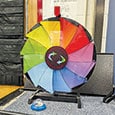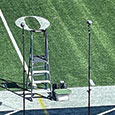All of the students watch the conductor, ready to breathe together. The group is about to play that final phrase of the piece, with the goal of bringing out the accents to achieve more contrast and character in the music. This is repetition five (the last repetition always requires the most concentration). Can we do it? The conductor’s baton lifts, and we are off. The students execute it beautifully and erupt with cheers and high fives. They won the game. Wouldn’t it be great to create those shared experiences more often in our classrooms? The following are some of the games most loved by my students that I use to not only create those moments in the classroom but help improve their performance level.
Repetition can be monotonous or entertaining, boring or dynamic. How teachers approach repetition with students determines whether we are developing engaged performers or robotic-like musical reflexes. Any artistic endeavor requires extraordinary patience with repetition, but how do you get middle school students to buy in? The answer is to create a dynamic environment, have set goals in mind, mix in some student choice, reward, and play some games.
The following activities can improve students attitudes about repetition and performance and create enjoyable classroom experiences. I have used them successfully with students of a wide range of abilities. To make the most of these games, you can adapt them to fit your students.
Clear The Board
For this game you will need a board (digital or physical to list your musical objectives), an oversized die, and a small plinko board. This game can be used to target any musical or technical objective. For example, you could ask students to play particular sections a certain number of times with 100% accurate notes and rhythms. Other goals could focus on dynamic expression or articulation such as whether they are doing the crescendo at measure 34 or separating the staccatos in a phrase. The beauty of this game is that it permits flexibility to meet students’ needs based on their current performance ability.
Set Up
This is one of my favorite games because the set up is so easy. The only step that requires time is writing out a prioritized list of musical goals for rehearsal. The picture below shows how I organize and present a list to the class.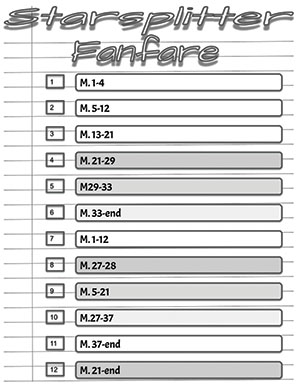
This is a bare-bones version so you can get the idea. I alter the number of musical priorities and put additional details for each based on my students’ abilities, class time, and attention spans. Make sure that you have a good mixture of challenge levels. Some should be easily attained while others might take some work. Nothing on the list should be something that they cannot accomplish in ten minutes. If students spend too long on the same objective, their attention and motivation will wane. Tailoring games to students’ abilities will increase their enjoyment of the game and improve your success in meeting musical objectives.
For the other items, you just need to set up the plinko board and puck that you drop in the board and label the bottom of the board with the student groups that you will create. If there is an uneven number for groups you can always add an everyone label that allows all students to get a point. The teacher passes out the dice to students when needed and keeps track of points during the game on the board.
Although you split the class into groups to distribute points, I try to avoid having groups competing against one another for the points. The way I use the plinko board creates a challenging game but avoids negative competition. I want to foster a positive team culture within the classroom that emphasizes improvement for all players. Everyone is on the same team, and all students should be able to enjoy the process regardless of ability. For my full band practices, I split the class into woodwinds, brass, and percussion. For divided classes (woodwind/brass and percussion), I place them into groups based on instrument.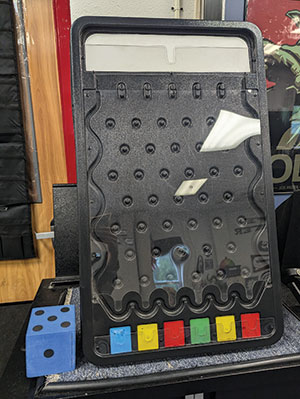
How To Play
I select one student from a group to start the game. As the game progresses, we rotate around the groups allowing for equal representation. Students from each group can raise their hand to volunteer for a task whenever they feel comfortable. Some prefer picking objectives from the board, while others prefer to roll the die or drop the puck. The goal is for all students to participate at their comfort levels.
The first student selected picks an objective from the board. Then, I ask for another volunteer to roll the die. This volunteer does not have to come from the group that chose the objective; it can be anyone. I favor choosing a new person for each step in the game to get more students involved, but you could have the same student pick an objective and roll the die. Whatever number the student rolled is the number of repetitions the group needs to successfully play in order to get a puck to drop.
When students accomplish the objective from the list, I ask for a volunteer to drop the puck. I pick a student from the same group that selected the objective to make it a fair rotation as the game progresses. It also helps to keep track of which group’s turn you are on. The student drops the puck and wherever it lands, that group receives the point. I love that the point is awarded by random drop so none of the students perceive the point in a negative manner. It lands where it lands, and this eliminates arguing and bickering. It also motivates students to keep the game moving so more pucks are dropped and more points are earned.
After we have been playing for a while, my students usually need an interest boost. One way to do this is to vary the number of puck drops for each successful objective, although each puck is always one point. The goal is for students to never lose hope that they can come back from low scores. This maintains their interest and positive attitude toward the game. We play until the end of the class period, and the group with the most points receives a prize like small pieces of candy or stickers. If the class can clear the board and successfully complete all of the objectives, then they get a bigger reward. At the end of the game, everyone has enjoyed some personal and group success along the way, leaving them ready to come back excited for the next day.
Alterations & Modifications
If you do not have a plinko board, you can cut out six pieces of paper and make a mark on one of those six. Then put it in a small container and have a student from each group draw one of the pieces of paper. The group of the student who pulls out the piece of paper with the mark receives the point.
Another modification to the game you can make is to the list itself. The example I included was based on phrases within a piece of music, but a list might have only one measure on it or even just going between two notes. Start where your students are. More success equals more enjoyment which will build their confidence.
Another modification that makes it more challenging is to only award a puck drop when students play the objective the rolled number of times correctly in a row. For example, if a student rolls a five, and the band plays it successfully four times in a row but makes a mistake on the fifth time, they would restart at one again. This modification works best for classes that like to be challenged and have a higher level of maturity. Younger or less mature students may get frustrated by the restart, and the accomplishment of the task may feel too far away for them. This can lead to a diminished effort.
Challenge The Spinner
For this game you need a spinner (either physical or digital) and a pop-it dice. (This is when the dice is in a small plastic container that you press to make it roll and that keeps it from flying around the room).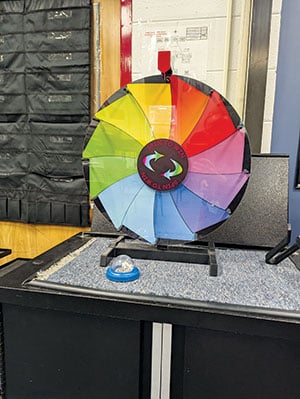
Digital spinners are prevalent online. I like to use the free website wheelofnames.com that allows you to type in your objectives and create as many options as you need. Once you spin, the program keeps track of everything you have landed on in the result section and also allows you to delete and keep objectives as you keep spinning. This is great if you want to let the students see the list narrowing down as they progress. I also use a physical spinner in my classroom.
Once again the objective of this game is the musical goal that you are trying to accomplish. Like the previous game, tailor this to your students’ needs and create a fun environment for improvement. The more careful thought you put into the musical objective, the better the outcome for your students.
Set Up
This game has a fairly easy set up as well. I put the pop-it dice on a tall stool so students have something to push down on that is not my podium. I also have a location for the physical spinner so that students can easily access it. If I am using a digital spinner I make sure that everything is set up so students can click to spin. I find engagement grows if they have a chance to click the spinner.
The most important part of the set up for this game is your list of musical objectives. These are typed into the digital spinner or written on the physical one. An advantage of a digital spinner is that it allows you to easily play the game multiple times in a day with different groups by having different spinners ready to go.
How To Play
For this game, I do not divide students into groups, and we play as a whole class. The way to win is to clear the spinner. On a physical spinner you cannot change how many ways it is divided but you can put the same sections on it multiple times as a way to modify for student success. Digital spinners let you put however many sections you want to attempt. You can also modify it by saying the class wins if there are three or fewer objectives remaining on the spinner as well.
A student spins the device to land on a musical objective. Then, another student pops the dice to get the number of repetitions they need to do successfully. If students do not meet the objective, another student comes up to spin again.
We play until the end of class or until all of the objectives are completed. Using small rewards (I use candy) helps future motivation. It is better for students to complete the game with some time left over in the class period than for them to not complete it at all. Remember that less is more. You want them to feel great about their successes and energized for the next class.
Alterations & Modifications
If you do not have a pop-it dice you could create two digital spinners – one for the objective list and another one for the number of repetitions. You could also just number pieces of paper with the number of repetitions you are going to use and put them in a bag and have students draw the number.
Another modification you can make is to the number of each roll. To challenge an advanced group, you can put a multiplier on it. I usually multiply the number by two or three when I do this.
You also can divide into groups and keep track of the points as in the previous game. I often ask students to come up with variations or their own games or ways of keeping points. They always have great ideas.
Summary
When rehearsals follow identical patterns day after day, drudgery can follow, and students often develop negative attitudes that diminish improvement. Games and activities have a remarkable ability to engage attention. Students are much more willing to partake in repetitive experiences when they are having fun. These games are a starting point for developing creative positive experiences with repetition and engaging rehearsals for your students.
